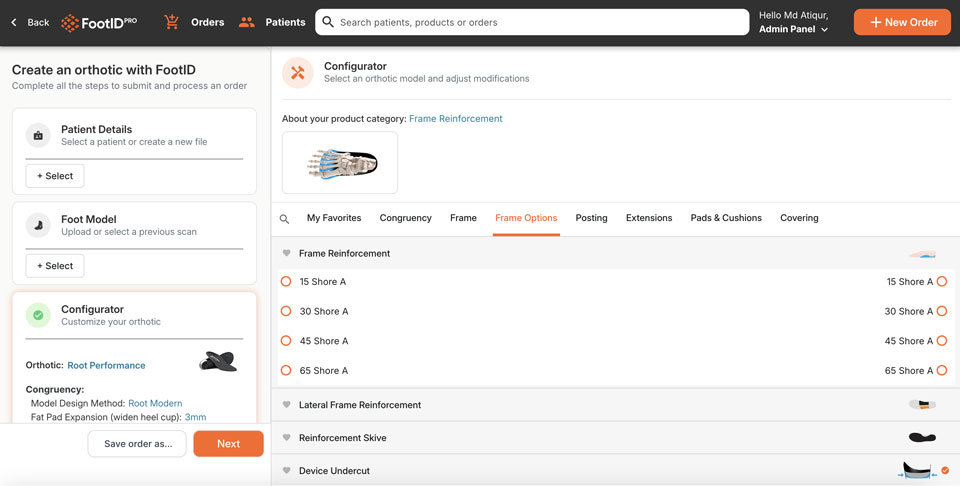By now, many KevinRoot Medical clients have gained experience with the FootID Pro app, and feel comfortable utilizing it to configure their orthotic prescriptions. Whether you choose to keep it simple, and select predetermined models in a quick few clicks, or have a stable of several favorite models memorized within the app, or want to take advantage of the many options available for orthotic customization to dial in a sophisticated biomechanical treatment plan based on whatever findings you have uncovered. Whether you adhere to strict biomechanical theory and wish to follow the teachings of Dr Root and others, or prefer to address a patient’s specific pathology and symptoms with a custom foot orthotic device, utilizing the Foot ID Pro will allow you to do so, quickly and accurately. Let us now continue reviewing the various aspects of the “Configurator”.

We last left off in the “Frame Options” column of the configurator, and now move on to the subject of flanges. There are two fields for flanges “Medial Flange” and “Lateral Flange” each with three options within the field; low, medium and high. Medial flanges are used to control excessive heel eversion, or rolling inward, and lateral flanges are used to control excessive heel inversion. There is a chain link icon in the middle/top of each field which allows you to add a flange either unilaterally or bilaterally. Medial flanges may be a good option with excessively pronated, hypermobile feet. Lateral flanges are primarily used in cases of lateral instability and to help prevent lateral ankle sprains.
Flanges differ from deep heel cups in that they are more vertically oriented than the curved heel cup, are not involved with the posterior of the heel cup, and generally extend more distally on the orthotic frame than a heel cup, but not as far as a UCBL device. I like to think of flanges as a guardrail for keeping the heel more vertically oriented on top of the orthotic device, preventing the heel from either rolling or sliding over the edge of the heel cup of the device. Cases of severe hypermobility where maximizing the ability of the orthotic to create stability, often require the use of both a medial and lateral flange. One note of caution, flanges should be considered carefully or avoided, if possible, if the patient participates in high impact sports, such as basketball, or requires enhanced shock absorption upon heel contact such as in long distance running.
The next four fields in the configurator pertain to “Frame Reinforcement". Frame reinforcement involves filling in the undersurface of the orthotic device and creating a flat surface for the bottom of the device. It is used to create enhanced stability and rigidity. I have found frame reinforcement to also provide prolonged durability with lessened plastic deformation over time. The first field allows a full frame reinforcement with four options as to the durometer, ranging from softer 15 shore EVA to firmer 65 shore EVA. Many models have default values for the frame reinforcement, so look for the orange checkmark in this field. Clicking the chain link will also provide the option of unilaterality versus bilaterality.

“Lateral Frame Reinforcement” is a frame filler under the outside half of the frame only, with similar options as the full frame reinforcement. This is used when lateral stability is desired in Pes Cavus for example or Cuboid instability, but medial flexibility is preferred, particularly in the medial arch area. "Reinforcement Skive” is a scalloping out of the frame filler, and allows for some reinforcement of the frame, but with reduced bulk. Clinical judgement as to how much reinforcement is needed is as much art as science.
“Device Undercut” is a measurement of how much of the frame filler (or rearfoot post) is vertically beveled under the side edges of the orthotic device, either inward or outward. The amount of undercut can vary, and often a default value is added into many models. The advantage of undercut is to reduce bulk weight and allow better fit into a shoe. Reducing or eliminating undercut will enhance stability, particularly in the frontal plane. “Lateral Flare Out” can be used when severe lateral instability is present, can help prevent the patient from rolling over the outside of the orthotic device, and serve somewhat as an outrigger to increase lateral stability.
I would like to emphasize that the usage of frame reinforcement can dramatically alter the performance and “feel” of your custom foot orthotic devices. Consider adding or subtracting frame reinforcement when patient feedback includes either too much or too little support provided by their orthotic devices.






